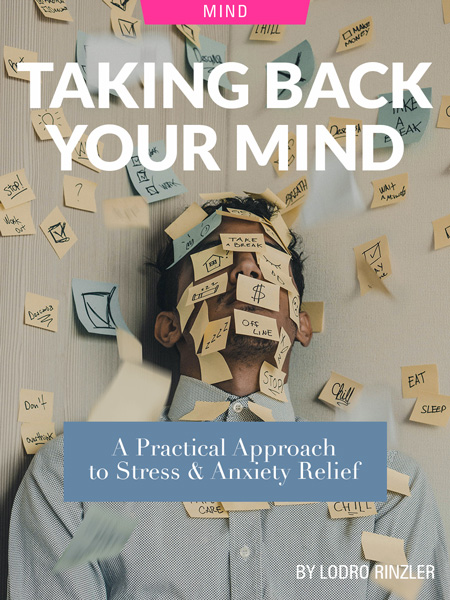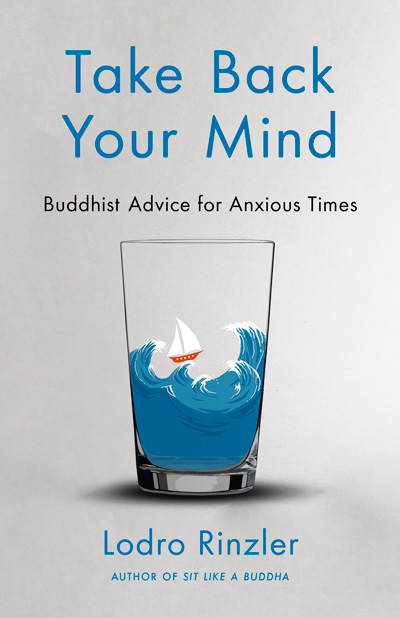Estimated reading time: 7 minutes
A meditation teacher and fellow occasionally anxious person shares Buddhist advice for calming the stressed-out mind
—
Pre-pandemic, I was at a dinner with friends. The music was pleasant, the food tasty, and the company divine. It’s rare this particular group gathers together so it felt like a real treat. At some point, the topic of politics came up (as it tends to at times), and I noticed when my friend Jonathan changed the subject. Later on, while we were exiting the restaurant, I took him aside and asked how he was doing. “I’m sorry about earlier,” he said, “but I’ve gotten so anxious, I have to watch a half hour of animal videos each night just to come back to some semblance of normal.”
I had no idea my friend’s anxiety had risen to this level, and while I was saddened to hear it, I figured watching animals play was better than what so many of us do to lessen the overwhelm that plagues us. Some are so on edge, they habitually pick up a bottle and pour a drink. Others prefer popping pills. Some throw themselves into work in some hopeless effort to ‘catch up’ and be free of work anxiety, pretending that tomorrow won’t bring new emails to respond to. So . . . animal videos? I could shrug and accept my friend’s coping mechanism pretty easily.
The conversation stuck with me though, giving birth to my noticing how all-pervasive and perpetual anxiety is for so many people. This realization in turn gave birth my new book, Take Back Your Mind: Buddhist Advice for Anxious Times, which was written during this most anxious of times, the pandemic.
Of course, it’s not just my friend who was experiencing new levels of stress leading to anxiety. According to one study, anxiety is the number one mental health problem among women and is second only to alcohol and drug abuse among men. Yet, this rampant problem is rarely addressed as a public health epidemic. Close to forty million people in the United States suffer from an anxiety disorder, according to the Anxiety and Depression Association of America [[1]]. And if we’re honest, that’s exactly what it is — an epidemic.
Anxiety is the monkey so many of us carry on our backs, one we always want to be rid of, yet rarely discuss.
So I figured I’d open the discussion. I’ve suffered with anxiety all my life. Ten-year-old me couldn’t even attend a sleepover at a friend’s house because it was too stressful. Though I started meditating at age six, it’s not like I was able to breathe away all the stressful triggers over the course of my life (nor at any point in Take Back Your Mind do I expect you to). I’ve had to work with multiple modalities, including various meditation techniques and ways of discerning how to reduce certain triggers, and look directly at anxiety itself, all in order to live a life that allows me to notice when anxiety arises, acknowledge it, and come back to reality.
The fact of the matter is we all have stressors in our lives — work deadlines, family issues, a whole pandemic throwing our usual routines out of whack — and the question becomes what do we do when that stressor slaps us in the face? The brain is a problem-solving device so it has a tendency to spin out every possible ‘What if’ storyline out there, moving us from a place of experiencing stress to locking ourselves in anxiety. So while I have times when stressful situations arise and get the best of me, I’ve learned over the years to unhook myself from the stories that keep me locked in that state and come back into the present moment much more quickly.
The odd and perhaps controversial thing about my book is that I point out there is a choice we make to keep ourselves locked in stress.
I know — it doesn’t feel like a choice. But who is telling you to be anxious? Did your boss, when she wrote you asking for that project to be in her inbox by end of day, also say, “And I want you to be anxious about it every minute from now until then?” I doubt it. I am guessing no one has ever told you that you need to be anxious. So who is holding you in that state? Well, bad news: it’s you.
There’s a traditional analogy in Buddhism that illustrates this point: A man is walking in the forest when, out of nowhere, he is shot with an arrow. Now, instead of pulling it out and tending to his own healing process, he begins to spin out, thinking “Who shot me? Why am I always the one being shot? Everyone else gets to go around being happy, but I take one walk in the woods and as usual, I end up in trouble. Chuck at work deserves to be shot, not me.” And so on. This mental spiraling is known as the second arrow.
Arrow #1: The suffering inflicted upon us as part of life.
Arrow #2: The suffering we inflict on ourselves in response.
We all experience arrows in our lives.
Rent comes due and not enough money is in your bank account. There are budget cuts at work. Your colleague says, “I need you to call me” (I just physically shuddered while typing that one!). These stressors are the first arrow. But instead of spending all day every day trying to problem-solve, dragging us deep into a rabbit hole of anxious thinking, we can acknowledge the situation, attend to it to the best of our ability, and be present for the rest of our lives.
It surprises no one that I as the long-term meditation teacher would recommend meditation here. But I won’t be Pollyanna about it and pretend that if you do a bit of meditation you no longer ever give into ‘the sky is falling’ anxious thinking. Instead of expecting meditation to be a twenty minute venture after which you’re cured of negative thinking forever more, we need to think of ‘stress-reduction’ and meditation as long-terms endeavors, not unlike learning a new language or working out.
These activities all take time: If you have been spending all your waking hours chasing ‘What if’ storylines then when you begin to engage in stress-reduction and meditation techniques it might feel akin to wading into the ocean and trying to turn the tide back with your own two hands. Yet the more we do it, day after day, week over week, the easier it becomes. You wouldn’t expect yourself to be fluent in a new language or lose 20 pounds overnight, would you? Why should we suspect that taming the mind of its anxiety would be any different?
Yet through engaging in a meditation practice and — here’s the juicy part — working with your mind in the other waking hours of your day, your mind quite literally changes.
These techniques rewire the brain and train it to notice when anxious stories pop up and not to go down the rabbit hole with each one. Instead, we train to unhook ourselves from that story, take a breath, and re-enter the present moment. That’s step one.
Step two is beginning to notice all of the goodness under our noses: the freshness of flowers on the mantle, our young child cooing contentedly in the other room, the warmth of the sun on our skin…all of these simple joys are waiting to be discovered if we can lift the veil of our own anxiety long enough to see them.
[1] Emma Pattee, “The Difference Between Worry, Stress and Anxiety,” New York Times, February 26, 2020
—
For more guidance you can check out Lodro Rinzler’s new book, Take Back Your Mind: Buddhist Advice for Anxious Times.
You may also enjoy reading Interview: Lodro Rinzler | A Mindful Life, by Kristen Noel.

